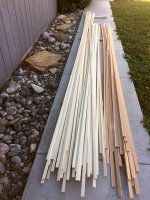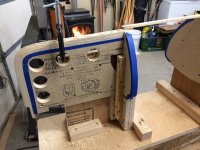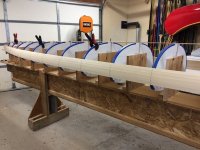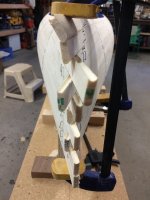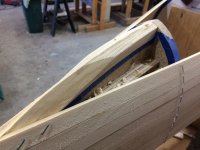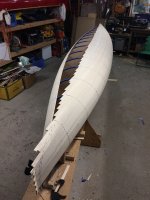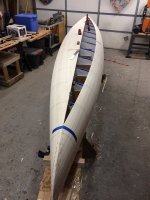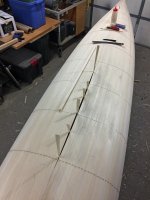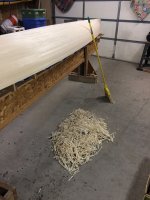I started working towards my next canoe build a little over a month ago and am just getting around to share a few of the details. Thanks to Deerfly and his documented build from last year I decided on the JEM Northwind as my next canoe build. The Northwind is essentially a strip version of Verlen Krugers Seawind solo decked canoe. The canoe is 17’2” long and 28.5” wide with a very low bow and stern and a deck that covers roughly ¼ the front and rear of the boat. I have been looking at this design for a number of years now, having a friend with two Kruger style boats and seeing the advantage of this design in bigger rivers, lakes and ocean paddling if neccesary. I own a sea kayak and have a number of friends with them, but ergonomically I am much more comfortable paddling a single blade and sitting upright. I’ve also had issues with tendonitis in the elbows, which is made worse with a kayak paddle. A canoe paddle seems to be no issue.
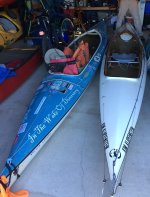
Kruger Seawind on the left and a Mad River Monarch on the right. Luckily I have access to these 2 boats for guidance on my build. The Seawind has been paddled by my friend Norm from Fort Nelson, BC to the Arctic Ocean and all the way up the Missouri River and down the Columbia River to the Pacific Ocean.
My desire is to build a reasonably strong boat while keeping the weight overall weight reasonable. I plan to do very little portaging with this boat. The main purpose for this boat is for long trips on rivers or big lakes, or just good old heavy trips with lots of stuff.
I’ve mentioned it in other threads, but I am able to get nice clear Englemann Spruce here in Montana in lengths up to 16 feet. The boards I can get are between 19 and 23 lb/ft3, which is the same or lighter than the western red cedar I have measured. The spruce is very tight grained and has other advantages over western red cedar in terms of hardness and elasticity. Another advantage is that the spruce is significantly less expensive than similar WRC.

The spruce, on the right, is nice tight grain, about 30 rings per inch.
Here's my layup:
Deck (top down):
4 oz. E-glass
1/4” Cedar
5 oz. Kevlar inside with extra reinforcements of glass around cockpit area
Hull (bottom up):
4 oz S-glass football with s-glass and dynel reinforcements on the stems
6 oz E-glass
1/4” Englemann Spruce
5 oz kevlar with reinforcements in the stems and seat/foot area
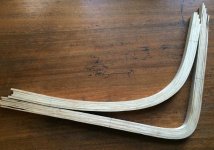
To add a little strength and impact resistance to the hull, I decided to add internal ash stems. Steam bent and laminated.
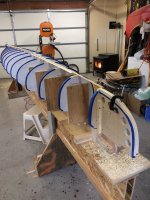
It was a toss up between trying to build this boat on my existing strongback, or making or buying solid beam to build the boat like a kayak. In the end I decided on using the strongback. It presents a few challenges building the boat this way, but in the end I’ll just have to pay extra close attention to getting the stations set up for the deck exactly the same as for the hull.
Mark

Kruger Seawind on the left and a Mad River Monarch on the right. Luckily I have access to these 2 boats for guidance on my build. The Seawind has been paddled by my friend Norm from Fort Nelson, BC to the Arctic Ocean and all the way up the Missouri River and down the Columbia River to the Pacific Ocean.
My desire is to build a reasonably strong boat while keeping the weight overall weight reasonable. I plan to do very little portaging with this boat. The main purpose for this boat is for long trips on rivers or big lakes, or just good old heavy trips with lots of stuff.
I’ve mentioned it in other threads, but I am able to get nice clear Englemann Spruce here in Montana in lengths up to 16 feet. The boards I can get are between 19 and 23 lb/ft3, which is the same or lighter than the western red cedar I have measured. The spruce is very tight grained and has other advantages over western red cedar in terms of hardness and elasticity. Another advantage is that the spruce is significantly less expensive than similar WRC.

The spruce, on the right, is nice tight grain, about 30 rings per inch.
Here's my layup:
Deck (top down):
4 oz. E-glass
1/4” Cedar
5 oz. Kevlar inside with extra reinforcements of glass around cockpit area
Hull (bottom up):
4 oz S-glass football with s-glass and dynel reinforcements on the stems
6 oz E-glass
1/4” Englemann Spruce
5 oz kevlar with reinforcements in the stems and seat/foot area

To add a little strength and impact resistance to the hull, I decided to add internal ash stems. Steam bent and laminated.

It was a toss up between trying to build this boat on my existing strongback, or making or buying solid beam to build the boat like a kayak. In the end I decided on using the strongback. It presents a few challenges building the boat this way, but in the end I’ll just have to pay extra close attention to getting the stations set up for the deck exactly the same as for the hull.
Mark

